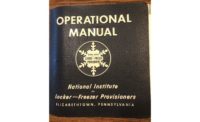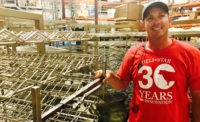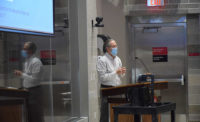Every meat processing plant is different, but there are some similarities, such as the sight of white-frocked employees busily working or moving between tasks. Colored hardhats usually differentiate the line workers from the supervisors, the federal or state inspectors and the visitors.
Food safety and employee safety is a primary concern for processors, and ensuring that everyone who walks onto the plant floor is dressed appropriately goes a long way toward alleviating those concerns.
The Code of Federal Regulations (CFR), which codifies all the rules published in the Federal Register by the federal government and its departments, lists the standards for employee clothing in Title 9, Chapter III, Section 416.5.
It reads, “Aprons, frocks, and other outer clothing worn by persons who handle product must be of material that is disposable or readily cleaned. Clean garments must be worn at the start of each working day and garments must be changed during the day as often as necessary to prevent adulteration of product and the creation of insanitary conditions.”
While that section concisely explains the requirements that every processor must follow, it leaves the choice of exact types of clothing up to each individual company.
“Plants will develop their own good manufacturing practices, and they’ll monitor operational sanitation over the course of the day and see if they’re complying with the written requirements,” says Jeff Stoterau, a consultant for ASI Food Safety Consultants. Those exact requirements will depend on if the plant is a slaughter operation, a ready-to-eat operation or a processing operation.
Processors can either launder employee frocks on a regular basis, or they can contract out those services to a third party that will pick up, launder and return the frocks to the facility. From his days as an FSIS inspector, Stoterau says he saw smaller processors that paid a stipend to have employees clean their own apparel, but he doesn’t recommend that method.
“Some people do a good job, and some don’t,” he reasons. “I think you’re better off, in my opinion, for the company to make sure that everybody’s on the same page.”
Training, to ensure that all employees know the proper dress code from boots to hairnet and helmet, is essential. When all the workers know the proper garments to wear, the more likely it is that an attentive employee will quickly spot someone out of uniform and bring it to his or her attention. Stoterau notes the typically high turnover rates at plants, which adds to the challenge.
“It all revolves around training and how well the facility has conducted these activities,” he says.




Report Abusive Comment